|
|
|
Sort Order |
|
|
|
Items / Page
|
|
|
|
|
|
|
| Srl | Item |
| 1 |
ID:
019942
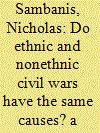

|
|
|
|
|
| Publication |
June 2001.
|
| Description |
259-282
|
|
|
|
|
|
|
|
|
|
|
|
|
|
|
|
| 2 |
ID:
175342


|
|
|
|
|
| Summary/Abstract |
Does theory contribute to forecasting accuracy? We use event data to show that a parsimonious model grounded in prominent theories of conflict escalation can forecast civil war onset with high accuracy and over shorter temporal windows than has generally been possible. Our forecasting model draws on “procedural” variables, building on insights from the contentious politics literature. We show that a procedural model outperforms more inductive, atheoretical alternatives and also outperforms models based on countries’ structural characteristics, which previously dominated models of civil war onset. We find that process can substitute for structure over short forecasting windows. We also find a more direct connection between theory and forecasting than is sometimes assumed, though we suggest that future researchers treat the value-added of theory for prediction not as an assumption but rather as a hypothesis to test.
|
|
|
|
|
|
|
|
|
|
|
|
|
|
|
|
| 3 |
ID:
180674
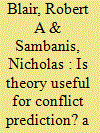

|
|
|
|
|
| Summary/Abstract |
Beger, Morgan, and Ward (BM&W) call into question the results of our article on forecasting civil wars. They claim that our theoretically-informed model of conflict escalation under-performs more mechanical, inductive alternatives. This claim is false. BM&W’s critiques are misguided or inconsequential, and their conclusions hinge on a minor technical question regarding receiver operating characteristic (ROC) curves: should the curves be smoothed, or should empirical curves be used? BM&W assert that empirical curves should be used and all of their conclusions depend on this subjective modeling choice. We extend our original analysis to show that our theoretically-informed model performs as well as or better than more atheoretical alternatives across a range of performance metrics and robustness specifications. As in our original article, we conclude by encouraging conflict forecasters to treat the value added of theory not as an assumption, but rather as a hypothesis to test.
|
|
|
|
|
|
|
|
|
|
|
|
|
|
|
|
| 4 |
ID:
077609


|
|
|
|
|
| Publication |
Princeton, Princeton University Press, 2006.
|
| Description |
xvii, 400p.
|
| Standard Number |
9780691122755
|
|
|
|
|
|
|
|
|
|
|
|
Copies: C:1/I:0,R:0,Q:0
Circulation
| Accession# | Call# | Current Location | Status | Policy | Location |
| 052369 | 341.584/DOY 052369 | Main | On Shelf | General | |
|
|
|
|
| 5 |
ID:
140172


|
|
|
|
|
| Summary/Abstract |
How do the outcomes of international wars affect domestic social change? In turn, how do changing patterns of social identification and domestic conflict affect a nation’s military capability? We propose a “second image reversed” theory of war that links structural variables, power politics, and the individuals that constitute states. Drawing on experimental results in social psychology, we recapture a lost building block of the classical realist theory of statecraft: the connections between the outcomes of international wars, patterns of social identification and domestic conflict, and the nation’s future war-fighting capability. When interstate war can significantly increase a state’s international status, peace is less likely to prevail in equilibrium because, by winning a war and raising the nation’s status, leaders induce individuals to identify nationally, thereby reducing internal conflict by increasing investments in state capacity. In certain settings, it is only through the anticipated social change that victory can generate that leaders can unify their nation, and the higher anticipated payoffs to national unification makes leaders fight international wars that they would otherwise choose not to fight. We use the case of German unification after the Franco-Prussian war to demonstrate the model’s value-added and illustrate the interaction between social identification, nationalism, state-building, and the power politics of interstate war.
|
|
|
|
|
|
|
|
|
|
|
|
|
|
|
|
| 6 |
ID:
177786
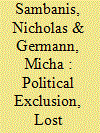

|
|
|
|
|
| Summary/Abstract |
Most civil wars are preceded by nonviolent forms of conflict. While it is often assumed that violent and nonviolent conflicts are qualitatively different and have different causes, that assumption is rarely tested empirically. We use a two-step approach to explore whether political exclusion and lost autonomy—two common causes of civil war according to extant literature—are associated with the emergence of nonviolent separatist claims, with the escalation of nonviolent separatist claims to war, or both. Our analysis suggests that different types of grievances matter more at different stages of conflict escalation. We find that political exclusion is a significant correlate of the escalation of nonviolent claims for self-determination to violence, while its association with the emergence of nonviolent separatist claims is weaker. By contrast, lost autonomy is correlated with both the emergence of nonviolent separatist claims and, if autonomy revocations are recent, their escalation to violence. We argue that these results are consistent with both grievance- and opportunity-based theories of conflict.
|
|
|
|
|
|
|
|
|
|
|
|
|
|
|
|
| 7 |
ID:
082412
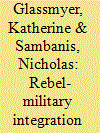

|
|
|
|
|
| Publication |
2008.
|
| Summary/Abstract |
Civil wars are far less likely to end in peace agreements than are international wars, and more than a third of civil wars restart within a few years. This may be due to the time-inconsistency of peace settlements in civil wars: once the rebels demobilize, they lose bargaining power and the government can renege on its promises. This makes rebels reluctant to stop fighting and quick to remobilize for a fight. A self-enforcing agreement could prevent this, but it is difficult to create such agreements. Recent efforts to structure self-enforcing agreements after civil wars have involved the integration of former rebels in a new national army. This solution should make unilateral defection from peace settlements more costly. This is an increasingly popular mechanism used in peace settlements, but it is not yet well understood. We do not know if it works or under what conditions it is likely to be used. This article provides the first systematic study of rebel-military integration agreements and considers if and how such agreements can help build peace. It also analyzes the conditions under which such agreements will be reached and implemented. The analysis suggests that rebel-military integration has not been an effective peacebuilding mechanism, but this is often due to poor implementation of the agreements
|
|
|
|
|
|
|
|
|
|
|
|
|
|
|
|
| 8 |
ID:
157911
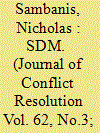

|
|
|
|
|
| Summary/Abstract |
This article presents a new data set on self-determination movements (SDMs) with universal coverage for the period from 1945 to 2012. The data set corrects the selection bias that characterizes previous efforts to code SDMs and significantly expands coverage relative to the extant literature. For a random sample of cases, we add information on state–movement interactions and several attributes of SDM groups. The data can be used to study the causes of SDMs, the escalation of self-determination (SD) conflicts over time, and several other theoretical arguments concerning separatist conflict that have previously been tested with incomplete or inferior data. We demonstrate the usefulness of the new data set by revisiting Barbara Walter’s influential argument that governments will not accommodate SD challengers if they face several potential future challengers down the road because they want to build a reputation for strength. We do not find support for Walter’s reputational theory of separatist conflict.
|
|
|
|
|
|
|
|
|
|
|
|
|
|
|
|
| 9 |
ID:
072552
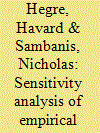

|
|
|
|
|
| Publication |
2006.
|
| Summary/Abstract |
In the literature on civil war onset, several empirical results are not robust or replicable across studies. Studies use different definitions of civil war and analyze different time periods, so readers cannot easily determine if differences in empirical results are due to those factors or if most empirical results are just not robust. The authors apply a methodology for organized specification tests to check the robustness of empirical results. They isolate causes of variation in empirical results by using the same definition of civil war and analyzing the same time period while systematically exploring the sensitivity of eighty-eight variables used to explain civil war in the literature. Several relationships with the onset of civil wars prove robust: large population and low income levels, low rates of economic growth, recent political instability and inconsistent democratic institutions, small military establishments and rough terrain, and war-prone and undemocratic neighbors. Variables representing ethnic difference in the population are robust only in relation to lower level armed conflict.
|
|
|
|
|
|
|
|
|
|
|
|
|
|
|
|
| 10 |
ID:
121123
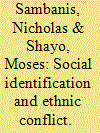

|
|
|
|
|
| Publication |
2013.
|
| Summary/Abstract |
When do ethnic cleavages increase the risk of conflict? Under what conditions is a strong common identity likely to emerge, thereby reducing that risk? How are patterns of social identification shaped by conflict? We draw on empirical results regarding the nature and determinants of group identification to develop a simple model that addresses these questions. The model highlights the possibility of vicious and virtuous cycles where conflict and identification patterns reinforce each other. It also shows how processes of ethnic identification amplify the importance of political institutions and traces the effects of national status and perceived differences across ethnic groups. Finally, we demonstrate how a small but sufficiently potent group of ethnic radicals can derail a peaceful equilibrium, leading to the polarization of the entire population. We reexamine several historical cases as well as empirical correlates of civil wars in light of these results.
|
|
|
|
|
|
|
|
|
|
|
|
|
|
|
|
| 11 |
ID:
167374
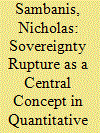

|
|
|
|
|
| Summary/Abstract |
Empirical studies of the causes or consequences of civil war often use measures that do not correspond to theory and results are sensitive to small changes in the coding of civil wars. Civil war is an instance of “sovereignty rupture” and is inherently a polity-level phenomenon, but that understanding of civil war is not reflected in data in which civil war is coded as a dyadic conflict—the state fighting a domestic challenger. We demonstrate the consequences of conceptual ambiguity about which conflicts to code as civil war and when to code the start and end of a civil war. Using a new data set of civil wars from 1945 to 2016 that is consistent with the concept of sovereignty rupture, we replicate several studies and find that their results are often overturned or weakened when we use our data. We advocate for greater deliberateness in data selection in civil war studies, focusing on the fit between the question of interest and the concept of civil war that is underlying a given data set.
|
|
|
|
|
|
|
|
|
|
|
|
|
|
|
|
| 12 |
ID:
183777
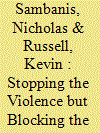

|
|
|
|
|
| Summary/Abstract |
Can third parties build nations after ethno-sectarian war? We provide a positive theory of peace building that highlights trade-offs that are inherent in any foreign intervention, narrowing the conditions for success even when interventions are well resourced and even-handed. A “sectarian” dilemma arises because peace must rely on local leaders, but leaders who earned their reputations through ethno-sectarian conflict have no incentive to stop playing the ethnic card and will not provide public goods. Intervention can shift those incentives if it stops ethnic violence and rebuilds state institutions. But an “institutional” dilemma arises if intervention crowds out local leaders, limiting state legitimacy and constraining the pace with which state building unfolds. The window for a lengthier, slower pace of foreign-led state building will close due to its own success as the population switches from ethnic to national identification, creating a “sovereignty” dilemma that pushes third parties out. If intervention ends before institutions can deepen leader incentives for a unifying nationalism, violence will likely recur. We provide an “intervention diagnostic” that reflects these three dilemmas, which are a function of the type of intervention, local political development, and the identity of the intervener. In deciding whether to intervene, the limits of building self-enforcing peace should be weighed against the likelihood and costs of ongoing violence.
|
|
|
|
|
|
|
|
|
|
|
|
|
|
|
|
| 13 |
ID:
080131
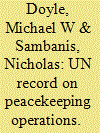

|
|
|
| 14 |
ID:
021417
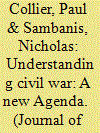

|
|
|
|
|
| Publication |
Feb 2002.
|
| Description |
3-12
|
|
|
|
|
|
|
|
|
|
|
|
|
|
|
|
| 15 |
ID:
165167


|
|
|
|
|
| Summary/Abstract |
This article studies the conditions that lead peripheral minorities to identify with the state, their ethnic group, or neighboring countries. We contribute to research on separatism and irredentism by examining how violence, psychological distance, and national status determine identification. The analysis uses data from a novel experiment that randomized videos of actual violence in a large, representative survey of the Kashmir Valley region in the Indian state of Jammu and Kashmir, an enduring site of separatist and irredentist conflict. We find that a strong regional identity is a counterweight to irredentism, but violent repression by the state can push members of the minority to identify with an irredentist neighbor. Violence increases perceived distance from the nation and reduces national identification. There is suggestive evidence that these effects are concentrated among individuals with attributes that otherwise predict higher levels of identification with the state. Information about integrative institutions and increased national status brought about by economic growth is insufficient to induce national identification in a context where psychological distance from the nation is large.
|
|
|
|
|
|
|
|
|
|
|
|
|
|
|
|
| 16 |
ID:
058794
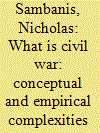

|
|
|
| 17 |
ID:
091424
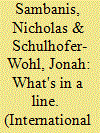

|
|
|
|
|
| Publication |
2009.
|
| Summary/Abstract |
Does territorial partition of countries in civil wars help to end these wars, reducing the risk of recurrence? Researchers have proposed territorial partition with or without formal recognition of sovereignty as a solution to civil wars and a way to create self-enforcing peace. Quantitative studies of the effect of partition on the risk of renewed civil war, however, suffer several main shortcomings, including conflicting results in the extant literature that result mainly from data coding differences, selective use of case histories, and methodological problems. A new data set and a benchmark empirical analysis find that, on average, partition is unlikely to reduce the risk of a return to civil war and, in some cases, may increase that risk.
|
|
|
|
|
|
|
|
|
|
|
|
|
|
|
|
|
|
|
|
|